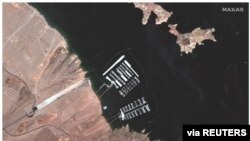Federal officials on Monday declared a first-ever water shortage on the Colorado River, triggering mandatory water supply cuts for several Western states in the river’s lower basin and Mexico in 2022.
The shortage was announced after a 20-year megadrought in the West brought water levels to a record low in the largest U.S. water reservoir, Lake Mead. The lake, fed by the Colorado River, serves nearly 25 million people in three Western states and Mexico.
Sitting at 35% capacity, the lake is at its lowest level since it was filled in the 1930s, according to the U.S. Bureau of Reclamation.
"This year, we’re seeing the combined effects of lower-than-average snowpack, hotter temperatures and drier-than-average soil conditions, and unfortunately that trend may continue," said Interior Department Assistant Secretary for Water and Science Tanya Trujillo in a news briefing.
Trujillo attributed the "unprecedented" environmental changes to climate change. According to a recent United Nations report, global warming may irreversibly worsen many effects of climate change, leading to more intense heat waves and longer droughts.
Water reductions will go into effect in 2022 for Arizona, Nevada and Mexico so the water and energy demands of communities that draw from the lake will continue to be met. California, the other state that Lake Mead supplies, is not affected by the first round of cuts.
The cuts are expected to hit farmers in Arizona especially hard, with the state losing about 18% of its annual Colorado River allotment. Nevada stands to lose about 7%, Mexico 5%.
The reductions represent 613,000 acre-feet of water in total. For perspective, one acre-foot can meet the water needs of one to two households for an entire year.
Lake Powell, the second-largest reservoir on the Colorado River, has also experienced plunging water levels in recent years, which may eventually result in shortages in Colorado, New Mexico, Utah and Wyoming, the states it supplies.







